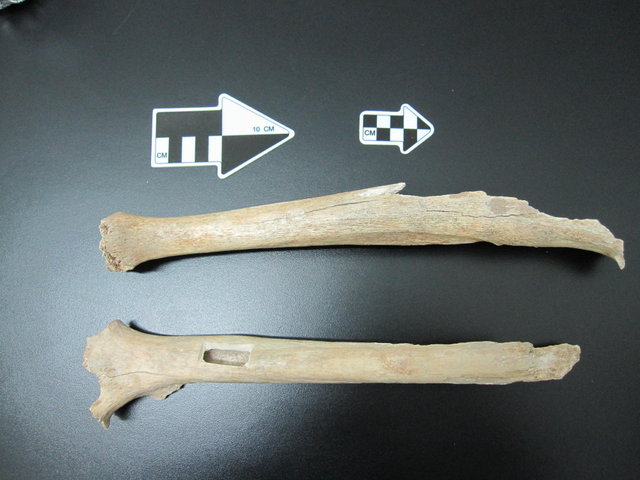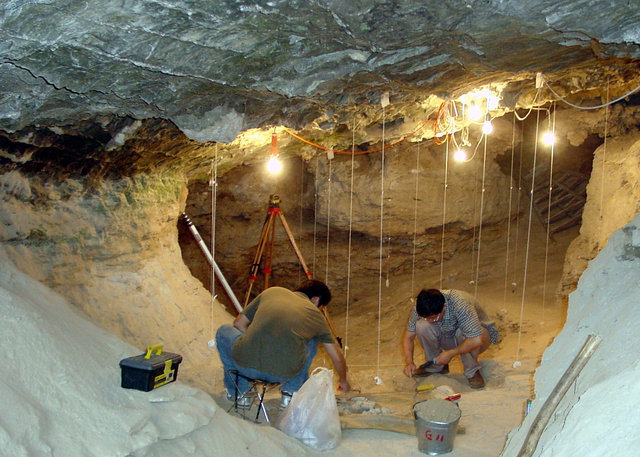It looks like you're using an Ad Blocker.
Please white-list or disable AboveTopSecret.com in your ad-blocking tool.
Thank you.
Some features of ATS will be disabled while you continue to use an ad-blocker.
11
share:
I normally dont really reed any of this kind of stuff but i find this fascinating and i would like to share it.
Hope it's in the right topic couldnt find any other that was more suited.
----------------------------------------------------------------------------------------------------------------------------

[size=2pt]'' The leg of the early modern human from Tianyuan Cave was used for the genetic analysis as well as for carbon dating. Credit: MPI for Evolutionary Anthropology ''

'' Researchers carrying out excavation works at the Tianyuan Cave from which the leg bones had been excavated in 2003. Credit: Institute of Vertebrate Paleontology and Paleoanthropology (IVPP), Beijing
Source:
psyh.org
Hope it's in the right topic couldnt find any other that was more suited.
----------------------------------------------------------------------------------------------------------------------------
Ancient DNA reveals humans living 40,000 years ago in Beijing area related to present-day Asians, Native Americans

[size=2pt]'' The leg of the early modern human from Tianyuan Cave was used for the genetic analysis as well as for carbon dating. Credit: MPI for Evolutionary Anthropology ''
An international team of researchers including Svante Pääbo and Qiaomei Fu of the Max Planck Institute for Evolutionary Anthropology in Leipzig, Germany, sequenced nuclear and mitochondrial DNA that had been extracted from the leg of an early modern human from Tianyuan Cave near Beijing, China. Analyses of this individual's DNA showed that the Tianyuan human shared a common origin with the ancestors of many present-day Asians and Native Americans. In addition, the researchers found that the proportion of Neanderthal and Denisovan-DNA in this early modern human is not higher than in people living in this region nowadays. Humans with morphology similar to present-day humans appear in the fossil record across Eurasia between 40,000 and 50,000 years ago. The genetic relationships between these early modern humans and present-day human populations had not yet been established. Qiaomei Fu, Matthias Meyer and colleagues of the Max Planck Institute for Evolutionary Anthropology in Leipzig, Germany, extracted nuclear and mitochondrial DNA from a 40,000 year old leg bone found in 2003 at the Tianyuan Cave site located outside Beijing. For their study the researchers were using new techniques that can identify ancient genetic material from an archaeological find even when large quantities of DNA from soil bacteria are present. The researchers then reconstructed a genetic profile of the leg's owner. "This individual lived during an important evolutionary transition when early modern humans, who shared certain features with earlier forms such as Neanderthals, were replacing Neanderthals and Denisovans, who later became extinct", says Svante Pääbo of the Max Planck Institute for Evolutionary Anthropology, who led the study.

'' Researchers carrying out excavation works at the Tianyuan Cave from which the leg bones had been excavated in 2003. Credit: Institute of Vertebrate Paleontology and Paleoanthropology (IVPP), Beijing
The genetic profile reveals that this early modern human was related to the ancestors of many present-day Asians and Native Americans but had already diverged genetically from the ancestors of present-day Europeans. In addition, the Tianyuan individual did not carry a larger proportion of Neanderthal or Denisovan DNA than present-day people in the region. "More analyses of additional early modern humans across Eurasia will further refine our understanding of when and how modern humans spread across Europe and Asia", says Svante Pääbo. Parts of the work were carried out in a new laboratory jointly run by the Max Planck Society and the Chinese Academy of Sciences in Beijing. More information: Qiaomei Fu, Matthias Meyer, Xing Gao, Udo Stenzel, Hernán A. Burbano, Janet Kelso, Svante Pääbo, DNA analysis of an early modern human from Tianyuan Cave, China, PNAS, Online Early Edition, January 21, 2013.
Source:
psyh.org
edit on 22-1-2013 by Dutcheagle because: (no reason
given)
geat find
heres a link to a thread by SLAYER here on ATS that coincides with this thread
www.abovetopsecret.com...
heres a link to a thread by SLAYER here on ATS that coincides with this thread
www.abovetopsecret.com...
S&F
Nice find, It is amazing that we find more and more old bones and proof of much older civilizations than we ever imagined.
Nice find, It is amazing that we find more and more old bones and proof of much older civilizations than we ever imagined.
reply to post by Dutcheagle
Any stone age tools or weapons found with or near the bone? I don't know how complete the stone tool/point record is in this area, or how they compare to later points in America and elsewhere.
Any stone age tools or weapons found with or near the bone? I don't know how complete the stone tool/point record is in this area, or how they compare to later points in America and elsewhere.
reply to post by Aleister
I believe you will find antecedants to their tool
tech in north America and not in Asia.
I believe you will find antecedants to their tool
tech in north America and not in Asia.
Originally posted by Aleister
reply to post by Dutcheagle
Any stone age tools or weapons found with or near the bone? I don't know how complete the stone tool/point record is in this area, or how they compare to later points in America and elsewhere.
Not that i have found out about but that could be indeed and to be honest i have no idea i will try to find out more.
Native Americans and certain Tibetan tribes had exactly the same traditions, customs and religious practises/beliefs. They also look quite alike. Here
is the material evidence that they were once linked, and perhaps their lifestyle is much older and was developed by this common ancestor?
If you want to hear more on these customs and values, it is quite beautiful in my opinion, youtube:
Manly Hall - Mystical Life of the American Indians
If you want to hear more on these customs and values, it is quite beautiful in my opinion, youtube:
Manly Hall - Mystical Life of the American Indians
I don't know why so many historians and archaeologist find it so hard to believe that man(DNA as today) was around 40,000 years ago and not the
more ancient ancestor. This just goes to show that maybe the evolution timeline that we think is accurate may not be so. This is an amazing find that
I hope will really open the eyes of people. But of course I doubt that the main stream media will report these finds because it validates the theories
of Forbidden Archaeologist, and they won't do that.
Originally posted by MadDuchess
I don't know why so many historians and archaeologist find it so hard to believe that man(DNA as today) was around 40,000 years ago and not the more ancient ancestor. This just goes to show that maybe the evolution timeline that we think is accurate may not be so. This is an amazing find that I hope will really open the eyes of people. But of course I doubt that the main stream media will report these finds because it validates the theories of Forbidden Archaeologist, and they won't do that.
The report is by scientists and reported by the MSM -that modern humans were in that part of Asia 40,000 years ago is not unusual or unexpected.
Originally posted by MadDuchess
I don't know why so many historians and archaeologist find it so hard to believe that man(DNA as today) was around 40,000 years ago and not the more ancient ancestor.
Errm, anatomically modern humans are considered to have been around for 200,000 years, so I'm not sure what you are on about.
This just goes to show that maybe the evolution timeline that we think is accurate may not be so.
Well, time will tell. However this discovery is exactly in line with what is expected by the currently accepted human development and migration timeline.
new topics
-
Joe Rogan conspiracy (maybe)
ATS Skunk Works: 1 hours ago -
Results of the use of the Oreshnik missile system in Dnepropetrovsk
World War Three: 4 hours ago -
Nigel Farage now the Most Favoured UK Politician
Regional Politics: 5 hours ago -
Little Johnny and Larry should team up
General Chit Chat: 11 hours ago
top topics
-
Results of the use of the Oreshnik missile system in Dnepropetrovsk
World War Three: 4 hours ago, 10 flags -
Little Johnny and Larry should team up
General Chit Chat: 11 hours ago, 9 flags -
Will Us use alien technology to fight in ww3?
World War Three: 12 hours ago, 2 flags -
Nigel Farage now the Most Favoured UK Politician
Regional Politics: 5 hours ago, 2 flags -
Joe Rogan conspiracy (maybe)
ATS Skunk Works: 1 hours ago, 2 flags
active topics
-
Well we know Putins ICBMs won't fail in their silos
World War Three • 207 • : Lazy88 -
Results of the use of the Oreshnik missile system in Dnepropetrovsk
World War Three • 108 • : CriticalStinker -
President-Elect TRUMP Picks Former Florida A.G. PAM BONDI to be U.S. Attorney General.
2024 Elections • 55 • : Xtrozero -
Jaguar Rebrand Video Causes "WTF?" Moment - Seriously Weird
Automotive Discussion • 26 • : angelchemuel -
Post A Funny (T&C Friendly) Pic Part IV: The LOL awakens!
General Chit Chat • 7815 • : baddmove -
Joe Rogan conspiracy (maybe)
ATS Skunk Works • 2 • : watchitburn -
Little Johnny and Larry should team up
General Chit Chat • 3 • : bluesman023 -
President-Elect DONALD TRUMP's 2nd-Term Administration Takes Shape.
Political Ideology • 238 • : WeMustCare -
Will Us use alien technology to fight in ww3?
World War Three • 11 • : BeyondKnowledge3 -
A Mysterious Orb filmed over NYC by local news
Aliens and UFOs • 25 • : ArMaP
11
